- Usage in publication:
-
- Knight or Coryphodon beds
- Modifications:
-
- Original reference
- Dominant lithology:
-
- Clay
- Sandstone
- AAPG geologic province:
-
- Green River basin
- Central Western Overthrust
Veatch, A.C., 1907, On the origin and definition of the geologic term "Laramie": Journal of Geology, v. 15, no. 6, p. 526-549.
Summary:
Pg. 547-549. Knight or Coryphodon beds of Wasatch group. Proposed for upper part of Wasatch of southwestern Wyoming containing CORYPHODON remains. Named from Knight Station [Uinta County], which is near place where fossils belonging to the genus were first found in North America, and where typical upper Wasatch is well developed. Rests unconformably on Fort Union. [Age is Eocene.]
[Knight Station on the Union Pacific RR, in NE/4 sec. 17, T. 14 N., R. 119 W., approx. Lat. 41 deg. 11 min. 40 sec. N., Long. 110 deg. 51 min. 16 sec. W., Sulphur Creek Reservoir 7.5-min quadrangle, Uinta Co., southwestern WY. Additional locality information from Veatch, 1907, USGS Prof. Paper 56, pl. 3 (geol. map), and USGS historical topographic map collection TopoView, accessed March 16, 2016.]
Source: US geologic names lexicon (USGS Bull. 896, p. 1112).
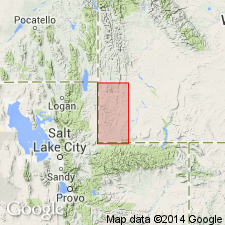
- Usage in publication:
-
- Knight formation*
- Modifications:
-
- Principal reference
- Dominant lithology:
-
- Clay
- Sandstone
- AAPG geologic province:
-
- Green River basin
- Central Western Overthrust
Summary:
Knight formation of Wasatch group. Variegated yellow and red sandy clays, with irregularly bedded white and yellow sandstones. Contains CORYPHODON and other animal remains. Thickness 500 to 1,500+/- feet. Top formation of Wasatch group in southwestern Wyoming. Underlies Green River formation and unconformably overlies Fowkes formation (middle formation of Wasatch group). [Age is Eocene.]
Named from Knight Station on the Union Pacific RR, in NE/4 sec. 17, T. 14 N., R. 119 W., [approx. Lat. 41 deg. 11 min. 40 sec. N., Long. 110 deg. 51 min. 16 sec. W., Sulphur Creek Reservoir 7.5-min quadrangle], Uinta Co., southwestern WY; see pl. 3 (geol. map). [Additional locality information from USGS historical topographic map collection TopoView, accessed March 16, 2016.]
Source: Publication; US geologic names lexicon (USGS Bull. 896, p. 1112).
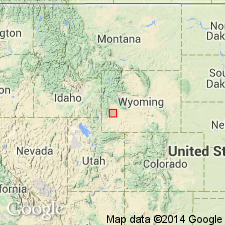
- Usage in publication:
-
- Knight member
- Modifications:
-
- Revised
- AAPG geologic province:
-
- Green River basin
Summary:
Pg. 60, 61, 62-63. Knight member of Wasatch formation. In south-central Sublette County, southwestern Wyoming, considered member in upper part of Wasatch formation. Consists essentially of soft red and maroon shales, variegated red and green poorly-lithified mudstones, coarse sandstones and arkose. Typical exposures in bluffs overlooking valley of Green River btw. towns of La Barge and Big Piney. [Thickness not stated.] Overlies New Fork tongue (new) of Wasatch. Conformably underlies Fontenelle member (new) of Green River formation. Fossils (vertebrates). Age is early Eocene (upper Wasatch).
Source: Publication; US geologic names lexicon (USGS Bull. 1200, 2040-2041).
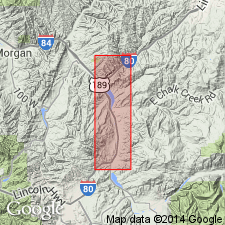
- Usage in publication:
-
- Knight formation
- Modifications:
-
- Areal extent
- AAPG geologic province:
-
- Uinta uplift
Summary:
Pg. 123 (fig. 1). In Coalville area, Utah, Knight formation, 2,000 feet thick, unconformably overlies Echo Canyon conglomerate (new). [Age is Eocene.]
Source: US geologic names lexicon (USGS Bull. 1200, 2040-2041).
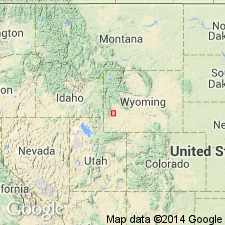
- Usage in publication:
-
- Knight Formation*
- Modifications:
-
- Not used
- AAPG geologic province:
-
- Green River basin
Summary:
Rocks assigned to parts of Wasatch Formation in this report on the Greater Green River basin of southwest WY were called Knight (Eocene) and Almy (Paleocene) formations by Veatch (1907). Neither Almy nor Knight considered useful terms in this report, [though neither name was abandoned].
Source: GNU records (USGS DDS-6; Denver GNULEX).
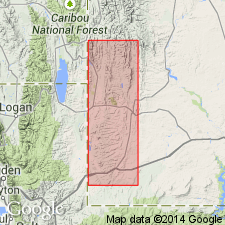
- Usage in publication:
-
- Knight Formation
- Modifications:
-
- Not used
- AAPG geologic province:
-
- Green River basin
Summary:
Rocks included in Knight Formation of Wasatch Group by Veatch (1907) are reallocated to the Wasatch Formation, and in places the Evanston Formation.
Source: Publication.
For more information, please contact Nancy Stamm, Geologic Names Committee Secretary.
Asterisk (*) indicates published by U.S. Geological Survey authors.
"No current usage" (†) implies that a name has been abandoned or has fallen into disuse. Former usage and, if known, replacement name given in parentheses ( ).
Slash (/) indicates name conflicts with nomenclatural guidelines (CSN, 1933; ACSN, 1961, 1970; NACSN, 1983, 2005, 2021). May be explained within brackets ([ ]).

